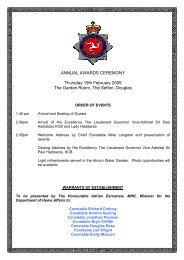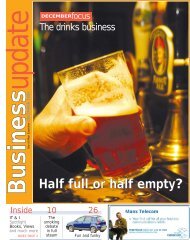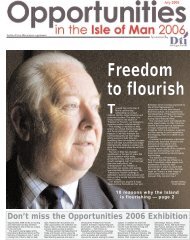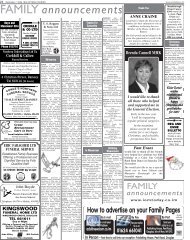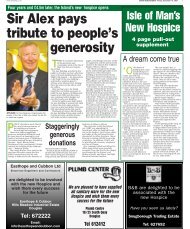m - Isle of Man Today
m - Isle of Man Today
m - Isle of Man Today
Create successful ePaper yourself
Turn your PDF publications into a flip-book with our unique Google optimized e-Paper software.
10<br />
m<br />
anxmillennium<br />
m<br />
anxmillennium<br />
15<br />
This magic lantern slide was once in the<br />
possession <strong>of</strong> Canon Spicer <strong>of</strong> Malew who died<br />
in 1919. The slide was one <strong>of</strong> many given to the<br />
<strong>Man</strong>x Museum by Mrs Riggall in 1951. The title on<br />
the slide is Hango Hill Farm although the property<br />
in the foreground was more commonly known as<br />
Mother Sch<strong>of</strong>ield’s Cottage and was demolished in<br />
1911. Note the thatched cottage behind it. Next<br />
comes a stackyard and then another complex <strong>of</strong><br />
thatched buildings and a tall building, Ballagilley<br />
but known as the Big Cellar on account <strong>of</strong> the cellar<br />
under the building. The properties belonged to King<br />
William’s College (The Big Cellar since 1933) and<br />
between Mother Sch<strong>of</strong>ield’s at Hango Hill they<br />
erected their indoor rifle range in a corrugated iron<br />
building. (MNH/pic/3429)<br />
One could be tempted to say it hasn’t changed<br />
but it has. This lantern slide is one <strong>of</strong> those<br />
given years ago by Mrs Riggall and came<br />
from Canon Spicer’s collection. On the left is the<br />
George Hotel with planters outside the front door.<br />
There is also planting on the balcony and at the top<br />
<strong>of</strong> the flat ro<strong>of</strong>s to the bay windows. Between the <strong>Isle</strong><br />
<strong>of</strong> <strong>Man</strong> Bank and the Barracks is a yard into which<br />
the Lloyds TSB building was erected within the past<br />
quarter <strong>of</strong> a century. Notice the tree planting on<br />
either side <strong>of</strong> the square in the roadway rather than<br />
in the footpath. On the right is the building which is<br />
now Barclays Bank but was built as an assembly room<br />
on the first floor with an open butcher’s market (or<br />
shambles) on the ground floor with all the arches<br />
extending to the ground level as a series <strong>of</strong> arcading.<br />
In the centre <strong>of</strong> the picture the building that<br />
successfully links Malew Street and Arbory Street.<br />
<strong>Man</strong>y will recall this as Collister’s grocers and tea<br />
stores. Note the traditional form <strong>of</strong> concrete pavements<br />
and macadam streets – no paving blocks and imitation<br />
cobble stones, and no bollards! (MNH/pic/3433).<br />
This view has been taken from a<br />
glass negative which has<br />
recently been given to the<br />
<strong>Man</strong>x Museum library to add to its<br />
vast treasurehouse <strong>of</strong> images <strong>of</strong> the<br />
Island since photography began.<br />
The inscription scratched onto the<br />
negative not only tells us the year<br />
but also the fact that the hulk <strong>of</strong> a<br />
ship berthed alongside the North<br />
Quay was a convict ship. She didn’t<br />
hold convicts here in Douglas but she<br />
had been used as a prison ship in<br />
Melbourne Harbour in 1853. She was<br />
called ‘Success’ and she was fitted out<br />
as an exhibition <strong>of</strong> her use with figures<br />
in irons and exhibition pieces such as<br />
the cat-o-nine -tails, sample cells, etc.<br />
She arrived at Douglas in 1911 and was<br />
set up with large advertising boards<br />
saying that she was the “World’s most<br />
remarkable vessel” . . . “visited by<br />
royalty”. From 1922 she toured America<br />
but was eventually destroyed by fire in<br />
1946 – 106 years old. (MNH/gift/679)<br />
Another G. B. Cowen view and another<br />
recent gift. This time it is a magic lantern<br />
slide and it bears the title “Two girls on the<br />
Claddagh Road”. It is a view I have seen before and<br />
shows Cronk Sumark in the background. A pair <strong>of</strong><br />
thatched cottages nearer to the camera were<br />
occupied by Jim Corlett on the left and Billy Pie on<br />
the right I rather think there was a fire in Jim’s<br />
house but perhaps there is a reader who can tell<br />
exactly what happened. (MNH/gift/679)<br />
Another recent gift <strong>of</strong> a<br />
photographic negative and again<br />
taken in 1912 showing the end <strong>of</strong><br />
the Victoria Pier. I have included this<br />
view because <strong>of</strong> what was on the end <strong>of</strong><br />
the pier. A step ladder lies against a<br />
navigational light. I wonder if the metal<br />
lattice work alongside was some form <strong>of</strong><br />
signalling to tell captains <strong>of</strong> approaching<br />
ships which side <strong>of</strong> the pier they were to<br />
head for berthing? The piece <strong>of</strong> equipment<br />
that tricked me is between the stepladder<br />
and the sign by the railings – a megaphone<br />
on a stand . . . “Come in Ben-my-Chree your<br />
time is up!” (MNH/gift/679)




